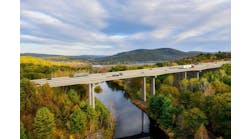Road construction in Atlanta is not always a welcome sight, but that is changing. A project involving a major widening of sidewalks and the addition of center islands is going on on Peachtree Street. However, the sight can be quite appealing. A variety of paving and landscape materials and fresh tree canopy are being installed over 15 miles, stretching from downtown Atlanta out to the Buckhead community.
The sensitive type
When streets and highways are designed in accordance with their physical and geographic location or setting, we call that context-sensitive design, or CSD. For example, freeways are appropriate only in rural areas, while boulevards and avenues are appropriate in cities. Rural roads don’t need sidewalks, while streets closer to the urban core need more and more pedestrian space. Rural homes can have driveways, suburban homes can have rear lanes and urban homes can have back alleys or courtyard entrances. Context-sensitive highway design considers the environmental, scenic, aesthetic, historical, community and preservation effects of a road project, as well as access for other modes of transportation, such as bicycling and walking. Context-sensitive highway design also involves local communities in planning for area transportation projects. Some of the direct benefits of CSD include increasing the connectivity of streets so as to provide more direct routes for pedestrians and bicyclists. Also, CSD provides attractive, accommodating pedestrian space on all streets and highways in heavily populated areas, and people can walk to shopping or work without fear of being hit by a vehicle.
Georgia State Highway 9, or Peachtree Street as it’s called in town, is in the midst of a $42 million renovation of sidewalks, lights and greenery. Peachtree Road, in north Atlanta’s Buckhead, is on the brink of being widened and beautified in the $22 million first phase of an effort that has been on hold for about two years. The result of both programs should be a pedestrian-friendly corridor that also keeps vehicular traffic moving at safe speeds. Construction schedules vary, but large portions should be completed by 2010.
The work is being fast-tracked by what are known as Special Tax Districts, which includes the Midtown Alliance and the Buckhead Community Improvement Districts. The groups are working toward the same objective: streetscapes that beckon to pedestrians and allow them to walk safely in high-traffic areas.
“I think we both are trying to create a pedestrian environment and to recognize that the road transportation system simply can’t be the only means to get around,” said Shannon Powell, Midtown Alliance’s vice president of planning and development. “We have to provide a walkable alternative that people are willing to use.”
Scotty Greene, executive director of the Buckhead Community Improvement District (CID), said the challenge along that portion of Peachtree involves the traffic heading to existing office buildings and several others that are to be built over the next five years, not to mention the retail magnets of Lenox Square and Phipps Plaza. The road has not kept pace with rising demands of both drivers and pedestrians, he said.
“This is a huge gutting of Peachtree Road to make it Peachtree Boulevard. The new boulevard is fitting right into the mixed-use, office and retail tower developments that are coming to Buckhead. We’re doing a combination of roadway operations improvements and streetscapes in which we’re adding pavers, trees, irrigated medians, bike lanes and cross walks. This is the biggest urban context design they’ve [Georgia DOT] ever attempted in a dense urban area.”
The goal of the project is to reinforce the high-density development core. This is accomplished in several ways, including:
- Promote moderate population density edges;
- Identify public gathering places;
- Develop green space;
- Enhance the pedestrian environment;
- Improve accessibility to and within Buckhead;
- Reinforce Peachtree Road as a destination;
- Envision Peachtree Road as a signature street;
- Develop local transit options; and
- Enhance safety.
The Peachtree Corridor Project is the Buckhead community’s first major transportation infrastructure improvement since the Georgia 400 link to I-285 was opened in 1993. The opening of Georgia 400 into and through Buckhead was a substantial transportation and growth milestone for this key regional activity center. Following the opening of Georgia 400, growth and accompanying traffic congestion in Buckhead rose rapidly, causing severe strain on its existing mobility networks.
The Buckhead community responded to these challenges with multiple community planning studies and surveys. These efforts led to the creation of the Buckhead CID and the Buckhead Area Transportation Management Association (BATMA) as tools to implement transportation and mobility solutions. Through these studies and forums, the citizens of the Buckhead community have repeatedly expressed their desire for roadways that move traffic more efficiently, streetscapes that enhance the pedestrian environment and better access to alternative modes of transportation.
Midtown classic
Downtown Atlanta and an area called Midtown have blurred together since Atlanta hosted the Centennial Olympic Games in 1996. Class A office space developments and residential projects have moved northward out of downtown into Midtown. From Midtown northward, the blurring continues on to the Buckhead community. This makes promotion of the continuity of the two distinct communities a logical next step.
The Peachtree Boulevard project represents a $42 million investment in the public environment. The scope of the extensive streetscapes effort include 10 key corridor projects encompassing more than 15 miles of improvements. The program will focus on improving sidewalk conditions including the addition and upgrading of new pavement, pavers, street lights, trees, on-street parking, traffic signals and other amenities.
“We are thrilled to be partners in helping the Midtown Alliance realize its vision for the future of this vibrant community,” said Arnie Silverman, chairman of Silverman Construction. “This five-year effort is an exciting and significant project that will have a tremendous positive impact on Midtown’s residents and visitors alike.”
The first phases will include the Piedmont-10th Street area, West Peachtree between North Avenue and 14th Street and Peachtree Street between 3rd and 10th streets.
As project manager for the streetscapes program, Silverman will lead a team of architects, planners and designers who have already dedicated a good deal of time to shaping the project. The entire project is to be completed over a five-year period and is being financed with federal, state and local funds. Silverman will lead each project from the concept phase through design, permits, bid and construction.
Decorative concrete supplied by Lafarge North America is currently being installed along the Peachtree Boulevard transformation. The plan is to widen sidewalks from a few feet currently out to 15 ft of 6-in.-deep pavement on both sides of the street. Finishes include stamped color surfaces along with light sandblast on gray concrete to give texture and warmth to the paving surfaces. Contractors are utilizing various colors in a 3,500 psi concrete mixture with a blend of 1 in. and 3?8-in. aggregate and a low-range water reducer to assure high finishability and uniformity. The 15 miles of streetscape projects are scheduled to last until 2007.


